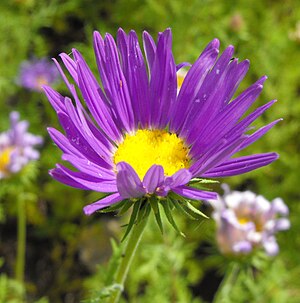Machaeranthera tanacetifolia
| Machaeranthera tanacetifolia | |
|---|---|

| |
| Scientific classification | |
| Kingdom: | Plantae |
| Clade: | Tracheophytes |
| Clade: | Angiosperms |
| Clade: | Eudicots |
| Clade: | Asterids |
| Order: | Asterales |
| Family: | Asteraceae |
| Genus: | Machaeranthera |
| Species: | M. tanacetifolia
|
| Binomial name | |
| Machaeranthera tanacetifolia | |
| Synonyms | |
|
Machaeranthera coronopifolia | |
Machaeranthera tanacetifolia is a species of flowering plant in the family Asteraceae known by the common names tansyleaf tansyaster and Tahoka daisy. It is native to northern Mexico and the southwestern and central United States, where it grows in several types of habitat. It is an annual or biennial herb growing one or more branching stems up to about 70 centimetres (28 inches) in maximum height. The multilobed leaves are up to 12 cm (4+3⁄4 in) long. The inflorescence bears one or more flower heads lined with spreading or curling, pointed phyllaries. The head has a center of many yellow disc florets and a fringe of many lavender to purple ray florets each 1 to 2 cm (1⁄3 to 2⁄3 in) long. The fruit is a flat achene about 1 cm long including the pappus.
It is similar to M. parviflora, the flower heads of which are smaller.[1]
Uses
The Zuni people use an infusion of the flowers taken with other flowers for unspecified illnesses.[2]
References
- ^ Spellenberg, Richard (2001) [1979]. National Audubon Society Field Guide to North American Wildflowers: Western Region (rev ed.). Knopf. pp. 386–387. ISBN 978-0-375-40233-3.
- ^ Camazine, Scott and Robert A. Bye 1980 A Study Of The Medical Ethnobotany Of The Zuni Indians of New Mexico. Journal of Ethnopharmacology 2:365-388 (p. 375)
External links
- Jepson Manual Treatment
- USDA Plants Profile
- Kansas Wildflowers
- Photo galleryError: "Q3274249" is not a valid Wikidata entity ID.
- Articles with short description
- Articles with 'species' microformats
- Taxonbars desynced from Wikidata
- Taxonbar pages requiring a Wikidata item
- Taxonbars with invalid from parameters
- Taxonbars without secondary Wikidata taxon IDs
- Flora of Mexico
- Flora of the Southwestern United States
- Plants used in traditional Native American medicine
- Astereae



